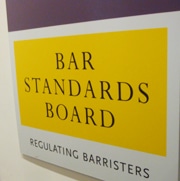Ignorance about fees, lack of public awareness and “excessive correspondence” from clients are just some of the challenges faced by direct access barristers, a major report by the Bar Standards Board (BSB) and Legal Services Board (LSB) has revealed.
The report highlighted the small amount of work done by most barristers registered for the scheme, with over 54% saying they did five or less direct access cases a year. However the “overwhelming consensus” was that the volume of work would increase over the next few years.
The research, by Pye Tait Consulting, contacted 404 barristers from the 5,700 registered for the scheme. The most common areas of work were family, chancery, employment, commercial and general common law.
Recommendation was the main source of instructions, although 43% reported that direct advertising by chambers had also brought in clients. Four in five of barristers had refused direct access instructions in the previous year, mainly because either the client or the case was inappropriate for the scheme.
The top three challenges cited by barristers were the administrative burden of direct access work, managing clients and ignorance about fees.
“Many respondents say they have to adapt to the very different demands for public access work in relation to more meticulous record-keeping, time spent dealing with what they perceive to be a larger volume of email instructions, and additional time spent on correspondence.”
Many barristers also said “managing client expectations” and “excessive correspondence” could be a “major barrier”.
On fees, the report found that “a lot of barristers have not known when to charge or what to charge in fees” and lacked knowledge of the market.
“Most respondents did not know what their peers working in similar practice areas would charge for public access work. Those that did have an idea of competitor costs had found this out in court when fees are read out, or by consulting their peers.”
According to the report, a “number of barristers interviewed” said “they knew they were undercharging” for their work.
At the same time, 43% of respondents reported an increase in the profitability of their practice as a result of direct access.
Direct access barristers cited “general lack of awareness” of the scheme as the biggest barrier for clients. Barristers also referred to a lack of understanding among clients and misunderstandings as to what barristers could and could not do via direct access.
“Furthermore some respondents say that prospective clients can have the perception that barristers are intimidating, difficult to engage and hard to contact. This is partly attributed to chambers and clerking infrastructures, which they say are designed for professional, rather than lay clients.”
However, the “overwhelming consensus” among direct access barristers was that the volume of work would increase in the next few years.
Nearly 70% said their workload had increased “by a lot or a little” in the past three years, while the report found that consumers could achieve an “overall cost saving” by not incurring solicitors’ fees.
“Respondents referred to a rise in the number of online portals advertising public access barristers as a key driver in increasing public awareness and understanding of the scheme. A small number of barristers expect that more intermediaries will start to refer work via the scheme as well.
“Clients, particularly corporate businesses, some of which may perceive a cost saving from the service, are expected to become repeat customers.”
However, a number of barristers “expressed concern about the potential for overlap and ‘blurring of the edges’ between the roles of the barrister and the solicitor”, particularly with barristers able to conduct litigation.
“A small number of barristers questioned whether this could result in tensions between the two professions, with fewer cases referred by solicitors to barristers as a result, and more direct competition for clients.”
The report found that barristers “do not believe there is a need to change the current regulatory framework, but instead consider that public access training and guidance should be improved, in order to help mitigate risks for both consumers and barristers”.
Ewen Macleod, director of regulatory policy at the BSB, said the report would be taken into account in deciding whether there needed to be “regulatory refinements” to the scheme.
Steve Brooker, head of research and development at the LSB, said that while representing a “relatively small proportion of a barristers’ caseload” direct access work was growing.
“Benefits for consumers that are starting to emerge from this key market liberalisation measure – wider choice, improved timeliness of access to services and lower costs – are important and can be expected to grow as public access work grows.”















The direct access route to a barrister is growing at a significant rate, ultimately the increase is due to a much wider communication of the benefits and subsequently the understanding and instruction by clients.
Whilst fees have been an issue in the past, at ShenSmith Barristers we only offer fixed fees so that element is not an issue, clients are informed in advance of any fees taken and have a clear choice with no nasty surprises after the event when the work has been undertaken. It’s what clients want.
Further details can be found via the ShenSmith Barristers website
http://www.shensmithbarristers.co.uk/
or via the youtube channel
https://www.youtube.com/user/shensmith
Further updates are available via twitter @SSBarristers or use the #Hashtag #Barrister